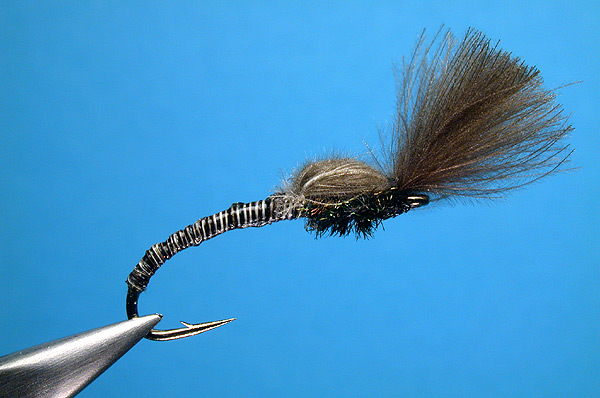Once and Away

Once and Away
This fly I personally find one of my best and most beautiful emerging patterns I ever made and is especially designed to be almost unsinkable. So it is suitable for all kinds of water. Unfortunately the fly is tied completely wrong by most people and need some special attention. This is a pattern I developed about 15 years ago during a few days fishing on one of our private rainbow-stocked reservoirs in Holland. The fish were fairly "educated" as they have been in the water for several months. On the first day of my trip, there was a lot of wind and fish were hard to catch. After a few hours without any success, I decided to try in front of some trees where I could stay out of this terrible wind. Here I saw some fish jumping and even some showing in a head and tail rises, especially where the wind hit the water. Immediately, I started to fish with my Klinkhamer, which is usually such a deadly fly for head and tailing fish. I saw some reactions and missed one fish when I tried to play with the fly in the surface. I was still convinced that those fish were rising to small flies that were being blown from the trees onto the water. After another half hour with no fish, and just when I started to doubt myself, a big rainbow came up to the surface just a few feet in front of me. He took something, hit the surface and disappeared into the depth again. There was only one explanation for this behaviour: This fish was feeding just under the surface. I changed the fly for the Culard fished it as an emerger below the surface and managed to catch nine fish that afternoon.
Still I was not satisfied because too many fished refused to take the fly and turned their head when they came close to the fly, so the next day I caught some of those remarkable emerging insects which I still couldn't determinate today! I concluded that their bodies were thin but the thorax seemed big and larger than usual. Walking back to my car, I tried to tie some suitable imitations. This was not easy as I had very few things with me. Without bobbin or hackle material I eventually managed to put together a fly with some CDC feathers that I had plucked off from of a dead duck I found beside the road that morning.
After a few attempts I decided on a tying that I thought might be successful. It was with considerable interest that I tried it out. My confidence in it was established within the first few casts. In the same time as it had taken me to catch fish on the previous day I caught many more. I called the fly the "Once and Away", since I had a great deal of difficulty in getting the pattern to float again after it had been dragged down by a fish. When I came home. I change the dressing to a better-looking and more durable pattern. To find a reasonable solution was not at all easy and drove me almost crazy. Finely after three months it were the thoughts behind the Rugged Caddis and Culard, which give me the answer. It is still funny to say and confess that just a simple cutting operation on the fly design cost me months to find out. Again I developed a pattern were CDC has been used against all rules.
MAKING THE WING
I take several CDC feathers as wing and wing case and cut them after finishing the tying process. I cut the wing in the middle to intergrades the stiff quills into the bunch of very fine fibres. With this technique the fly is not only very easy to dry but floats really well. The visibility is unbelievable and because I use curved hooks, the hooking power is much better. There are no casting problems and a perfect landing ensures that this pattern always hangs in the surface film. The other benefit of this pattern is that it has a similar effect as a real parachute fly.
USING THE WIND
This fly can do a lot more with some good casting and making use of the wind. With a little exercise you can play around with this fly all the time, especially in still water. Let the wind give this pattern some extra action and movements and I am sure you will be amazed. I prefer to fish this pattern in or very close to a wind-lane. The wind will bring it to the feeding fish.
Today I use the Once and Away in rivers and in still waters. Even the strongest current could not swallow this fly from the surface.
Tying technique
(step by step photographs: Leon Links)
- Fix the hook in the vice and wrap the shank with the tying thread.
Tie in the peccary hair or any fine quill fiber as substitute to form a nice
tapered body. Just make a few patterns only using tying thread as body and
see how they turn out!

- Tie in four large CDC feathers together with three peacock strands.

- Wind the peacock herls to form the thorax.

- Pull de CDC over the thorax and tie them down just behind the eye
with just two tight windings.

- Pull the feathers into an upright position and secure them this way with a lot of tying thread in front of the wing. When you prefer using varnish. Take care that nothing will come into the fine fibers.

- Trim the feathers into a tuft, the size depending on the size of fly or your preference. I like a tuft 1/2 to 2/3 hook shank long.
Back to Thumbnails
